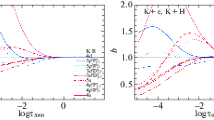Abstract
A method to analyze the statistical equilibrium of the EuII ion based on a 36-level model atom has been developed. The formation of EuII lines without assuming local thermodynamic equilibrium (LTE) is considered for T eff=5500–7000 K, logg=4.0, and metallicities [A] from 0 to −1.5. Non-LTE effects in the level populations are primarily due to radiative pumping of excited states from the ground and low-lying levels, which leads to over-population of upper relative to lower levels. As a result, the studied λ4129 and λ6645 Å lines are weaker than in the LTE case. However, due to the small energy differences between even low-lying EuII levels, collisional coupling is strong, and deviations from LTE in EuII lines are modest: for the Sun, non-LTE corrections to the abundance are only 0.04 dex. The non-LTE effects grow with an increase in the effective temperature and with a decrease in the metallicity, so that non-LTE abundance corrections can reach 0.12 dex for T eff=5500K, logg=4.0, [A]=−1.5 and 0.1 dex for T eff=7000K, logg=4.0, [A]=0. The effect of inaccuracy in the atomic parameters for EuII on the non-LTE calculations is examined. Analysis of the profiles of the solar EuII λ4129 and λ6645 Å lines is used to empirically refine estimates of the efficiency of collisional processes in forbidden transitions in establishing the distribution of EuII ions over excited states.
Similar content being viewed by others
References
L. I. Mashonkina and I. F. Bikmaev, Astron. Zh. 73, 109 (1996) [Astron. Rep. 40, 94 (1996)].
L. I. Mashonkina, T. Gehren, and I. F. Bikmaev, Astron. Astrophys. 343, 519 (1999).
G. J. Mathews, G. Bazan, and J. J. Cowan, Astrophys. J. 391, 719 (1992).
A. G. W. Cameron, Astron. Astrophys., Suppl. Ser. 82, 123 (1982).
E. Anders and N. Grevesse, Geochim. Cosmochim. Acta 53, 197 (1989).
R. G. Gratton and C. Sneden, Astron. Astrophys. 287, 927 (1994).
W. C. Martin, R. Zalubas, and L. Hagan, Atomic Energy Levels—The Rare Earth Elements, NSRDS-NBS 60 (US Gov. Print. Off., Washington, 1978).
F. Kupka, N. Piskunov, T. A. Ryabchikova, et al., Astron. Astrophys., Suppl. Ser. 138, 119 (1999).
V. A. Komarovskii, Opt. Spektrosk. 71, 559 (1991) [Opt. Spectrosc. 71, 322 (1991)].
R. L. Kurucz, CD-Roms, Nos. 18, 19 (1994).
G. Peach, Mem. R. Astron. Soc. 71, 13 (1967).
H. van Regemorter, Astrophys. J. 136, 906 (1962).
C. W. Allen, Astrophysical Quantities (Athlone, London, 1973; Mir, Moscow, 1977).
H.-W. Drawin, Z. Phys. 164, 513 (1961).
I. I. Sobelman, L. A. Vainshtein, and E. A. Yukov, Excitation of Atoms and Broadening of Spectral Lines (Nauka, Moscow, 1979; Springer, Berlin, 1981).
W. Steenbock and H. Holweger, Astron. Astrophys. 130, 319 (1984).
Y. Takeda, Pub. Astron. Soc. Jpn. 46, 53 (1994).
N. A. Sakhibullin, Tr. Kazan. Gor. Astron. Obs. 48, 9 (1983).
L. H. Auer and J. Heasley, Astrophys. J. 205, 165 (1976).
L. I. Mashonkina, N. A. Sakhibullin, and N. N. Shimanskaya, Astron. Zh. 73, 212 (1996) [Astron. Rep. 40, 187 (1996)].
R. O. Doyle, Astrophys. J. 153, 987 (1968).
D. Gray, The Observation and Analysis of Stellar Photospheres (Wiley, New York, 1976; Mir, Moscow, 1983).
R. L. Kurucz, I. Furenlid, J. Brault, and L. Testerman, Solar Flux Atlas from 296 to 1300 nm (Nat. Solar Obs., Sunspot, New Mexico, 1984).
D. Biehl, Sonderdruck der Sternwarte Kiel, No. 229 (1976).
M. Steffen, Astron. Astrophys., Suppl. Ser. 59, 403 (1985).
L. I. Mashonkina, Model Atmospheres and Spectrum Synthesis, ASP Conf. Ser. 108, 140 (1996).
H. Holweger and E. Muller, Solar Phys. 39, 19 (1974).
N. Grevesse, A. Noels, and A. J. Sauval, Astron. Soc. Pac. Conf. Ser. 99, 117 (1996).
K. Butler, private communication (1999).
Author information
Authors and Affiliations
Additional information
__________
Translated from Astronomicheski\(\overset{\lower0.5em\hbox{$\smash{\scriptscriptstyle\smile}$}}{l} \) Zhurnal, Vol. 77, No. 8, 2000, pp. 630–640.
Original Russian Text Copyright © 2000 by Mashonkina.
Rights and permissions
About this article
Cite this article
Mashonkina, L.I. Non-LTE analysis of the formation of EuII lines in the atmospheres of solar-type stars. Astron. Rep. 44, 558–568 (2000). https://doi.org/10.1134/1.1306356
Received:
Issue Date:
DOI: https://doi.org/10.1134/1.1306356




